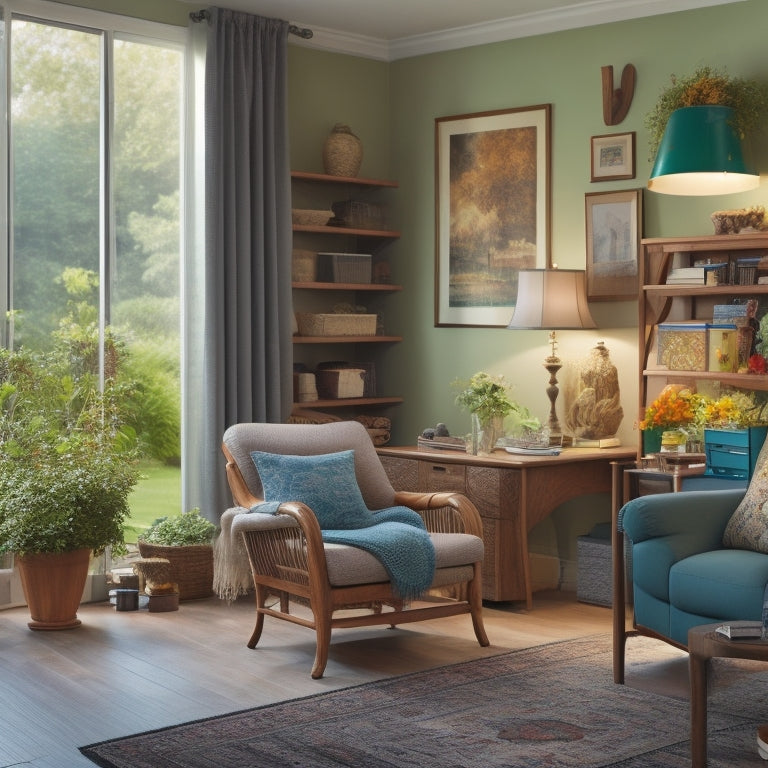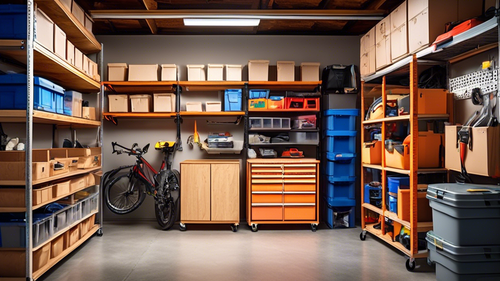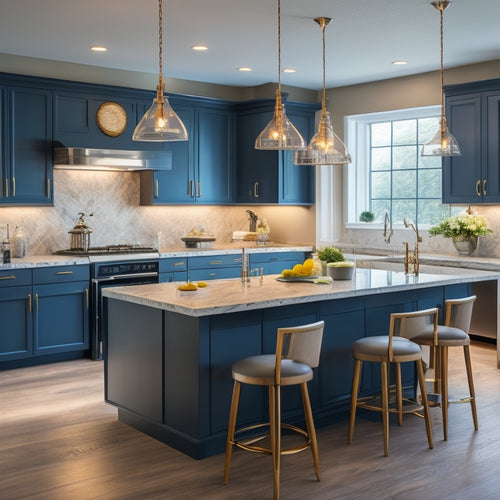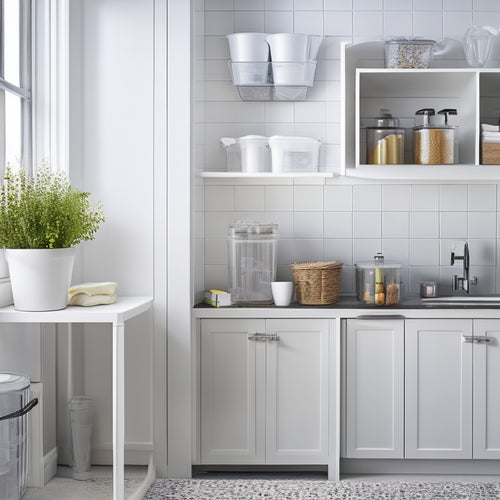
Accessible Home Organization for Seniors and Disabilities
Share
You can create a living space that works for you, not against you, by implementing simple yet effective organizational strategies. Start by clearing tripping hazards and rearranging furniture for easy orientation. Use multi-tiered storage units and pull-out drawer organizers to reduce bending and straining. Senior-friendly labeling and signage can also help you quickly identify items and stay on top of daily tasks. By adapting your space to your needs, you can regain control over your daily routines and maintain your independence. Now, uncover how to customize your space even further with these accessible home organization solutions.
Key Takeaways
- Clear pathways and optimize furniture arrangement to reduce fall risk and improve accessibility for seniors and individuals with disabilities.
- Utilize multi-tiered storage units, pull-out drawer organizers, and shelves with baskets to enhance visibility and accessibility of everyday items.
- Implement senior-friendly labeling and signage with color-coded labels, large print, and clear concise labels for easy categorization and identification.
- Create a safe and clutter-free kitchen with ergonomic tools, non-slip mats, and labeled food expiration dates to reduce fall risk and improve functionality.
- Integrate technology, such as smart home assistants, to enable voice-controlled automation, streamline daily routines, and enhance safety and independence.
Adapting Spaces for Easy Navigation
As you move through your home, you may find yourself maneuvering around cluttered areas or struggling to reach high shelves, which can be frustrating and even hazardous.
By adapting your spaces, you can create a more navigable environment that allows you to move freely and safely. Start by clearing pathways of tripping hazards and rearranging furniture to create open routes.
Consider swapping heavy or bulky furniture for lighter, more manageable pieces. Additionally, evaluate your living spaces for functionality optimal storage solutions and implement a structured filing system with digital solutions and labeled folders to maximize space.
This will enable you to move around your home with greater ease and confidence. By optimizing your furniture arrangement, you can create clear pathways that make it easier to get from one room to another, reducing the risk of falls and injuries.
Simplifying Storage for Everyday Items
Frequently, you find yourself searching for everyday items like keys, wallets, or reading glasses, only to realize they're nowhere to be found. This can be frustrating and time-consuming. To simplify storage for everyday items, consider using multi-tiered storage units or shelves with pull-out drawers. This allows you to store items in a logical and accessible manner.
| Storage Solution | Benefits | Ideal Location |
|---|---|---|
| Multi-tiered storage unit | Visible and easily accessible | Entryway or hallway |
| Pull-out drawer organizer | Reduces bending and straining | Kitchen or bathroom |
| Shelf with baskets | Keeps items hidden from view | Living room or bedroom |
| Key hooks | Designated spot for frequently used items | Near front door |
| Tray or dish | Contains small items | Near reading area |
Senior-Friendly Labeling and Signage
You've worked hard to create a storage system that makes sense for your needs, but without clear labels and signage, it can be difficult to remember where you've placed items.
That's why senior-friendly labeling and signage are essential. Use color-coded labels to categorize items, such as red for important documents and blue for household items. This visual cue will help you quickly identify what's inside a container or on a shelf.
Additionally, use large print labels to make it easy to read, even if your eyesight isn't what it used to be. Clear and concise labels will give you confidence in your ability to find what you need when you need it, reducing frustration and anxiety.
Creating a Safe and Clutter-Free Kitchen
In the heart of your home, the kitchen can quickly become a hub of clutter and disorganization, making meal prep a challenging task. To create a safe and clutter-free kitchen, start by clearing off countertops and decluttering cabinets. Consider ergonomic tools like easy-grip utensils and adaptive cookware that make cooking easier and safer.
| Kitchen Safety Tip | Ergonomic Tool | Benefit |
| Remove tripping hazards | Non-slip mats | Reduces fall risk |
| Label food expiration | Large-print labels | Improves food safety |
| Lower heavy items | Pull-out shelves | Reduces strain |
Accessible Closets and Wardrobe Solutions
As you maneuver your daily routine, getting dressed can become an intimidating task when your closet is cluttered and disorganized. However, with a few simple adjustments, you can create a wardrobe accessibility haven.
Start by sorting your clothes into categories, and consider a closet organization system with shelves and rods at comfortable heights. This will enable you to easily access your favorite pieces without straining or struggling.
You can also install pull-out shelves, drawers, or bins to store items like socks, underwear, and accessories. By optimizing your closet space, you'll regain control over your daily routine and enjoy a sense of independence when getting dressed.
Technology Integration for Independent Living
You're probably familiar with smart home assistants like Alexa or Google Home, but did you know they can be a transformative innovation for independent living?
With voice-controlled automation, you can control lighting, temperature, and even security systems without having to leave your favorite armchair.
Smart Home Assistants
Take control of your living space with smart home assistants, designed to simplify daily tasks and promote independence.
These innovative tools allow you to manage your home with ease, using voice commands or mobile apps. With smart home integration, you can seamlessly connect various devices and systems, creating a cohesive and automated living environment.
Here are three ways smart home assistants can enhance your daily life:
-
Streamlined Routine: Set notifications, schedule appointments, and receive alerts with personalized voice assistant features.
-
Effortless Control: Dim lights, adjust thermostat settings, and lock doors with a simple voice command or tap on your mobile device.
-
Enhanced Safety: Receive alerts for unusual activity, monitor your home's security, and get assistance in emergency situations.
Voice-Controlled Automation
With your smart home assistant, you can seamlessly integrate various devices and systems to create a voice-controlled automation system, allowing you to maintain independence and control over your living space. This technology enables you to perform tasks with ease, using voice recognition to command devices and systems. For instance, you can set automated notifications to take medication, turn on lights, or adjust the thermostat with just your voice.
| Device/Feature | Voice-Controlled Functionality |
| Lighting System | Turn lights on/off, dim, or brighten with voice commands |
| Thermostat | Adjust temperature, set schedules, and receive notifications |
| Medication Alerts | Receive automated notifications to take medication |
| Home Security | Arm/disarm security systems, receive alerts, and monitor cameras |
| Entertainment | Play music, videos, or podcasts with voice commands
Frequently Asked Questions
How Can I Maintain Organization Systems With Cognitive Decline or Memory Loss?
You can maintain organization systems despite cognitive decline or memory loss by using memory aids like calendars and to-do lists, setting routine prompts on your phone, and breaking tasks into smaller, manageable chunks to stay on track.
Are There Any Grants or Funding for Home Organization Adaptations?
You can investigate grant eligibility and funding sources, like the Department of Veterans Affairs or non-profit organizations, that support home modifications, including organization adaptations, to create a more accessible and independent living space that suits your needs.
Can I DIY Home Organization Adaptations or Do I Need a Professional?
You can DIY simple home organization adaptations, but for complex projects, consider professional assistance to guarantee safety considerations are met; invest in organization tools that cater to your needs, and don't hesitate to ask for help when needed.
How Do I Organize for a Senior With Hoarding Tendencies?
When you're wading through a sea of clutter, start by understanding the senior's hoarding triggers, then develop gentle, non-judgmental organizing strategies that enable them to take control, one small step at a time, and celebrate each victory along the way.
Are There Any Organizations That Offer Free or Low-Cost Home Organization Services?
You can find local resources offering free or low-cost home organization services through non-profits, churches, or community centers; look for organizations providing community support, like Meals on Wheels or senior centers, which may offer additional assistance.
Related Posts
-

Garage Roof Storage: Options and Considerations
The Unseen Space Saver As a homeowner, I've always faced the dilemma of finding ample storage space without clutte...
-

7 Kitchen Island Designs With Built-In Seating
You're looking for a kitchen island that not only provides additional counter space and storage but also incorporates...
-

Corner Solutions for Kitchen Cleaning Supplies
You can investigate corner solutions that improve access to cleaning supplies. This can be practiced by maximizing hi...


